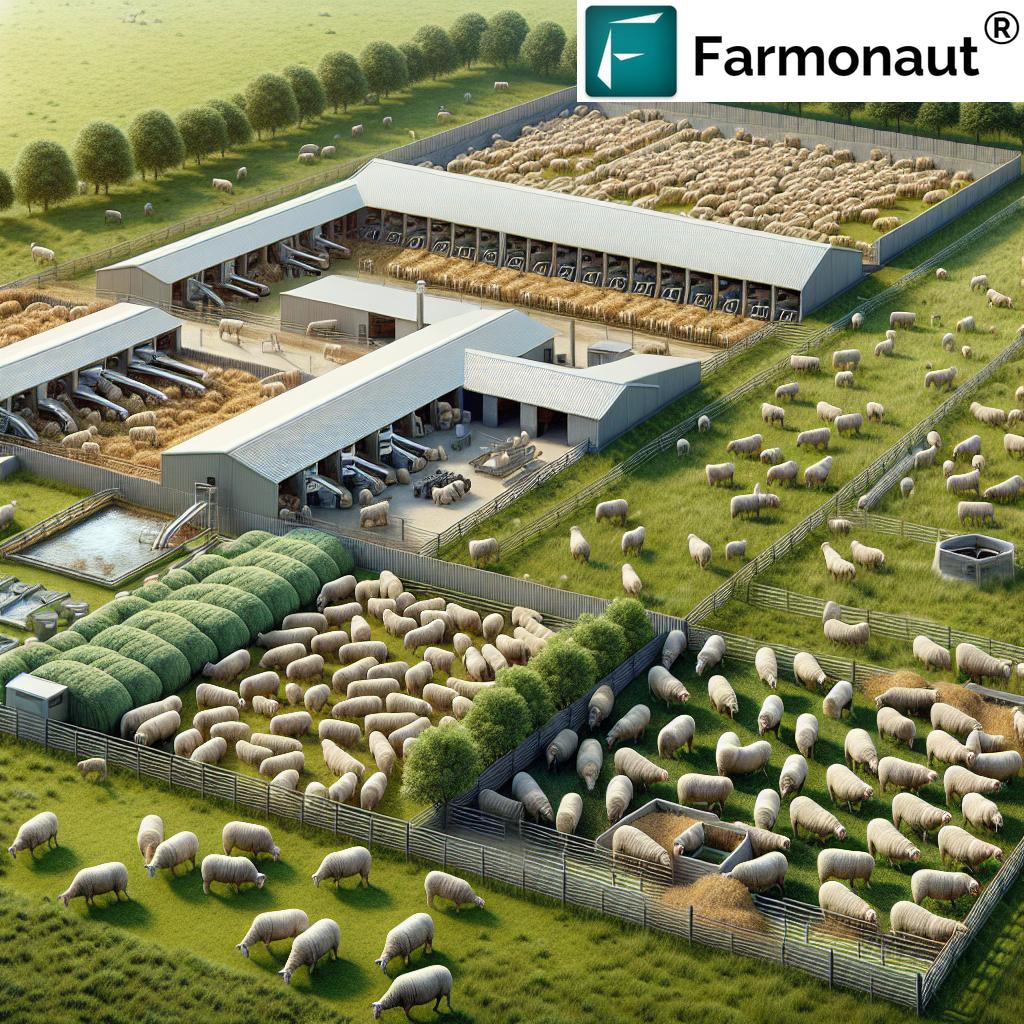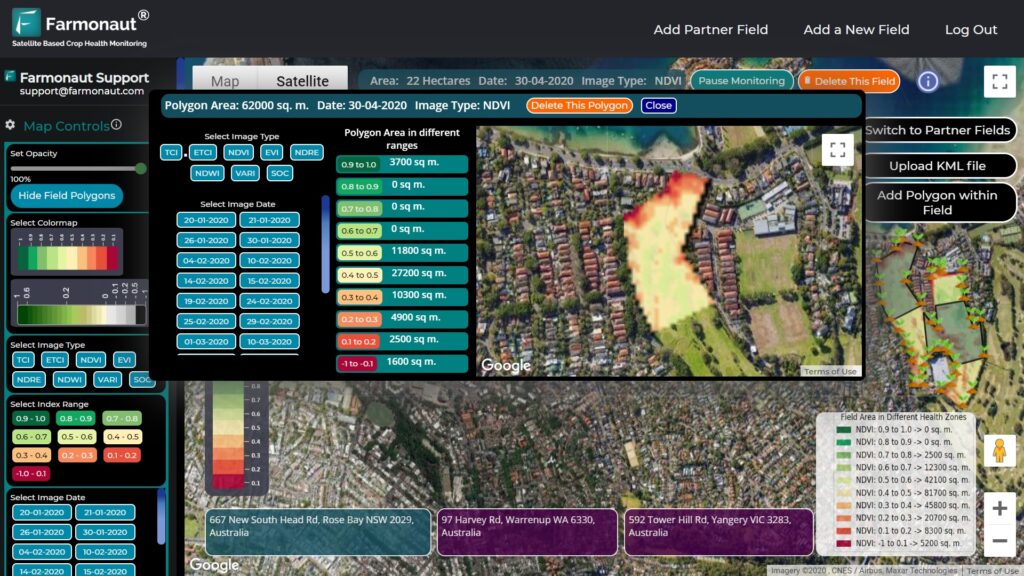Sheep Farm Management: 10 Shocking Secrets for Success
“Did you know? Proper nutrition can boost sheep wool yield by up to 30% annually.”
Table of Contents
- Comprehensive Guide to Sheep Farm Management
- The 10 Shocking Secrets of Sheep Farm Management
- Sheep Farm Management Practices Comparison Table
- Sheep Housing and Facilities
- Sheep Nutrition and Feeding
- Sheep Health Care Practices & Disease Prevention in Sheep
- Breeding Management in Sheep
- Rotational Grazing for Sheep & Pasture Management
- Biosecurity Measures for Sheep Farms
- Record Keeping, Monitoring, and Performance
- Sustainable Sheep Farming Practices
- Farmonaut’s Role in Modern Sheep Farm Management
- Must-Have Resources, Links, and Videos
- Frequently Asked Questions (FAQ)
- Conclusion
Comprehensive Guide to Sheep Farm Management
Effective sheep farm management is pivotal for ensuring the overall health, productivity, and sustainability of your flock. Managing sheep successfully requires integrating evidence-based practices spanning housing, nutrition, breeding, biosecurity measures, disease prevention, and sustainable farming. In this guide, we explore ten powerful secrets that can transform your sheep farm, combining traditional know-how with technological advances for modern farms.
As passionate sheep managers, we know that actionable knowledge and the right tools are the keys to thriving, resilient farms. This guide covers every essential aspect, including details on rotational grazing for sheep, comprehensive sheep health care practices, and technologies offered by Farmonaut for data-driven farm oversight.
Let’s delve deeper into each secret—arming ourselves with expert advice to improve animal welfare, maximize yields, and ensure the long-term success of every sheep farming endeavor!
The 10 Shocking Secrets of Sheep Farm Management
To achieve outstanding results and set our flock apart, we must look beyond everyday routines. Here are the ten most impactful and sometimes surprising secrets of professional sheep farm management:
- Prioritizing Proper Sheep Housing and Facilities
- Mastering Sheep Nutrition and Feeding
- Implementing Comprehensive Health Care & Disease Prevention
- Strategic Breeding Management in Sheep
- Using Rotational Grazing for Sheep and Advanced Pasture Strategies
- Rigorous Biosecurity Measures for Sheep Farms
- Proactive Record Keeping and Continuous Monitoring
- Maximizing Sustainable Sheep Farming Practices
- Leveraging Technology for Data-Driven Management
- Continuous Learning and Adaptation
Each of these secrets can revolutionize your flock’s health, welfare and farm profitability! Let’s break them down, one by one, and discover exactly how to implement them effectively on any scale of operation.
Sheep Farm Management Practices Comparison Table
| Management Practice | Estimated Benefit (% Increase in Productivity) | Implementation Difficulty | Estimated Cost ($/sheep/year) |
|---|---|---|---|
| Proper Housing & Facilities | 18% | Medium | $12 |
| Targeted Nutrition & Feeding | 23% | Medium | $19 |
| Comprehensive Health Care & Disease Prevention | 29% | High | $25 |
| Strategic Breeding Management | 15% | Medium | $13 |
| Rotational Grazing for Sheep | 21% | Medium | $10 |
| Vigilant Biosecurity Measures | 14% | Low | $6 |
| Proactive Record Keeping | 12% | Low | $3 |
| Adopting Sustainable Practices | 16% | Medium | $11 |
| Technology-Driven Management (Farmonaut, etc.) | 25% | Low-Medium | $15 |
| Continuous Learning & Improvement | 10% | Low | $2 |
Summary: Combining these ten strategies can boost flock productivity by more than 60%, while supporting sustainable, profitable, and resilient farm management for years to come!
Secret #1: Prioritizing Proper Sheep Housing and Facilities
Sheep housing and facilities form the backbone of any successful operation. Our sheep deserve clean, safe, and comfortable environments that shield them from extreme weather, minimize stress, and enhance welfare. Here are the essential practices for outstanding sheep housing:
- Provide Shelter Against Temperature Extremes: In warm climates, ensure barns or sheds have adequate ventilation and shade to avoid overheating. In colder regions, buildings must be insulated with dry bedding and ammonia buildup prevented by frequent cleaning.
- Designate Specific Areas: Always create separate spaces for lambing, sick animals, and new or quarantined animals to reduce disease transmission.
- Maintain Cleanliness and Hygiene: Regular replacement of bedding (straw, wood shavings, etc.) and routine sanitation are vital. Clean waterers and feeding troughs minimize the risk of diseases and digestive issues.
- Prevent Overcrowding: Uncrowded pens or barns reduce animal stress and provide comfort, which aids in growth and productivity.
- Accessible Facilities: Housing must allow for easy cleaning and animal access to ensure daily routines run smoothly.
Pro tip: Design housing with both “closed” spaces for severe weather and “open” yards for exercise. Well-managed housing prevents common issues like footrot and pneumonia while reducing unwanted behaviors.
Secret #2: Mastering Sheep Nutrition and Feeding
Sheep nutrition and feeding directly influence flock growth, reproduction, immune function, and wool production. Sheep are ruminants and thrive on diets rich in high-fiber forages like fresh pasture and quality hay. Here’s how we ensure optimal sheep nutrition:
- Always Feed Fiber-First: The majority of nutrition should come from forages—grass, legumes, and hay. This supports healthy rumen function.
- Supplement When Necessary: In periods of limited pasture, supplement with grains and high-energy feed. However, introduce grains gradually (over 1–2 weeks) to avoid digestive issues like acidosis or bloat.
- Provide Free-Choice Minerals: Use minerals formulated for sheep (including selenium) available at all times to prevent deficiencies and support metabolism.
- Support Young Lambs: Offer creep feed starting at about two weeks of age to promote rapid growth and development.
- Fresh, Clean Water Access: Water must be accessible at all times, as even short periods without water reduce feed intake and productivity.
Benefits: Proper nutrition boosts growth rates, immune response, and even wool yield by up to 30%. High-fiber diets, fresh water, and tailored mineral mixes are irreplaceable for healthy and profitable flocks.
“Effective disease prevention reduces sheep mortality rates by nearly 40% on well-managed farms.”
Secret #3: Implementing Comprehensive Sheep Health Care Practices & Disease Prevention in Sheep
Every sheep farmer’s nightmare is an outbreak of illness. Fortunately, with robust sheep health care practices and a focus on disease prevention in sheep, we can keep our flocks healthy and thriving. Here are the fundamentals:
- Strategic Vaccination: Administer routine vaccinations, especially against clostridial diseases (CD-T), which are common and deadly without vaccinations.
- Selective Deworming: Avoid blanket worming and instead use fecal egg counts to selectively treat only animals needing deworming. This preserves drug effectiveness (sheep parasite control strategies).
- Routine Hoof Trimming: Prevents lameness and associated welfare and production issues.
- Quarantine New Arrivals: Always quarantine new animals for at least 30 days to avoid introducing new diseases to the flock.
- Maintain Facility Hygiene: Regular disinfection, rodent control, and waste management are crucial to reduce disease transmission.
- Implement Regular Health Monitoring: Track animal health data (illness, weight, treatments, etc.) to identify illness early and monitor treatment efficacy.
Common Issues Managed: Footrot, pneumonia, enterotoxemia, parasitism, and more—all can be minimized with proactive care and prevention measures.
Did you know? With proper disease management, sheep mortality can be reduced by nearly 40%—a tremendous boost to your farm’s bottom line.
Tip: For an advanced edge in monitoring pasture conditions, grass growth, and detecting environmental changes that may impact sheep health, try the Farmonaut Large Scale Farm Management platform. It offers powerful satellite-based monitoring and data-driven advisory accessible via web, Android, and iOS.
Secret #4: Strategic Breeding Management in Sheep
Breeding management in sheep is more than selecting rams and turning them loose. Proper strategies shape the growth, genetics, and long-term profitability of our flocks. Here’s what smart breeding involves:
- Timing and Age: Ewe lambs should be bred at about 8 months or when they achieve 65% of mature body weight. This ensures safe pregnancies and optimal growth.
- Body Condition: Both ewes and rams need to be in excellent condition prior to breeding to improve conception rates and lamb survival.
- Separation for Adequate Nutrition: Separate young ewe lambs from mature ewes after weaning to ensure targeted feeding and better reproductive outcomes.
- Active Monitoring During Lambing: Designate spaces for lambing, provide assistance with difficult births, and keep records to improve both current and future flock productivity.
- Genetic Selection: Carefully select rams for desirable traits—growth rates, wool quality, parasite resistance, etc.
Outcome: Strategic breeding accelerates flock improvement, enhances disease resistance, maximizes lamb survival, and enhances profitability.
For traceable breeding histories and genetic records, Farmonaut’s Blockchain-Based Product Traceability system ensures secure, transparent breeding documentation. This supports premium markets and guarantees authenticity in supply chains.
Secret #5: Using Rotational Grazing for Sheep & Advanced Pasture Strategies
Rotational grazing for sheep is a proven method to boost pasture productivity, reduce parasite burdens, and promote ecosystem balance. Here’s how we should implement it:
- Divide the Farm into Multiple Paddocks: Run sheep on small sections for 3–7 days, then move to the next. This allows pasture to rest and regrow.
- Monitor Forage Condition: Adjust stocking and movement based on pasture height and species present. Avoid overgrazing that can compromise regrowth and increase weed problems.
- Control Parasite Loads: Removing sheep from pasture for 28–35 days helps break parasite life cycles and supports sheep parasite control strategies.
- Use Mixed or Multi-Species Grazing: When possible, rotating with cattle or goats can further reduce parasite density in pasture.
- Promote Groundcover and Soil Health: Rotational grazing supports long-term sustainability by protecting soil, retaining nutrients, and supporting beneficial plants.
Result: Farms adopting rotational grazing typically increase forage yield, reduce the need for supplemental feed, and see healthier, more productive sheep.
Extra Tool: Monitoring regrowth and pasture rotation schedules is easy with Farmonaut’s web or mobile platform, which leverages satellite imagery for real-time pasture monitoring and health tracking. Click here to try Farmonaut on the web or app!
Secret #6: Rigorous Biosecurity Measures for Sheep Farms
Biosecurity measures for sheep farms are our “security net” against catastrophic disease outbreaks. A single new disease can wipe out months of hard work. Here’s a comprehensive guide to strong sheep farm biosecurity:
- Control Animal Movement: Restrict access to your farm only to essential personnel. Always quarantine new or returning animals for a minimum of 30 days.
- Disinfection Protocol: Clean and disinfect equipment, boots, and vehicles that enter sheep-holding areas. Provide footbaths at all barn entrances.
- Rodent, Pest, and Bird Control: These can spread parasites and bacteria. Maintain clean feed storage and block rodent access.
- Proper Waste Disposal: Dispose of manure, bedding, dead animals, and afterbirth promptly and safely.
- Veterinary Partnerships: Establish a working relationship with a local vet for routine flock health monitoring and support.
Pro tip: Create written biosecurity plans and update them annually.
Farmonaut aids insurers and banks in satellite-based verification for Crop Loans and Farm Insurance, making access to emergency credit and risk management easier for sheep farmers.
Developers & Agri-businesses: Farmonaut API | API Developer Docs – Extend sheep farm analytics, weather, and pasture monitoring functionalities into your own digital solutions!
Secret #7: Proactive Record Keeping, Monitoring, and Performance
Diligent record keeping is one of the least visible—but most critical—practices for sheep farm management. Informed decisions depend upon up-to-date, accurate records:
- Track Individual Animal Data: Maintain logs of birth weights, growth rates, health treatments, breeding records, lambing success, and reasons for culling.
- Feed and Pasture Management: Record types and volumes of feed or pasture use, grazing schedules, and supplemental nutrition.
- Monitor Flock Financials: Annotate input costs, market prices, and revenue streams to evaluate profitability.
- Automation & Digital Tools: Platforms like Farmonaut make documentation simple and accessible on both mobile and desktop.
Benefits: Comprehensive records allow for the quick identification of trends, early detection of health or management issues, and evidence-based improvements year-to-year.
Secret #8: Maximizing Sustainable Sheep Farming Practices
Sustainable sheep farming practices are the key to balancing productivity with environmental care and long-term resource security. Many modern farms now routinely implement the following methods:
- Integrated Pest Management (IPM): Blend biological controls, grazing rotation, and cultural methods to minimize chemical use and enhance parasite control.
- Efficient Water Use: Harvest rainwater, use smart irrigation, and avoid overwatering pasture to save costs and protect the environment.
- Organic Practices: Cut out synthetic fertilizers and pesticides in favor of natural soil enhancers and pest deterrents.
- Promote Carbon Footprinting: Monitor and reduce environmental impact with modern carbon tracking tools.
Want to measure and reduce your farm’s climate impact? Explore Farmonaut’s Carbon Footprinting Tool—track real-time emissions, make greener decisions, and stay compliant with sustainability regulations.
Secret #9: Leveraging Technology for Data-Driven Sheep Farm Management
Modern sheep farming is made exponentially more efficient and profitable by the rise of advanced technologies. Farmonaut stands at the forefront, offering game-changing tools for farm management:
- Satellite-Based Crop & Pasture Monitoring: Assess pasture health, growth rates, and drought stress using NDVI and other vegetation indices—no field visit required!
- Real-Time AI Farm Advisory: Receive instant recommendations on grazing, nutrition, and risk prevention via the Jeevn AI system based on weather and actual pasture conditions.
- Blockchain Traceability: Trace your sheep, wool, or lamb products from farm to consumer for full supply chain transparency.
- Fleet & Resource Management: For larger operations and agribusinesses, optimize logistics—vehicle use, field operations scheduling—with Farmonaut’s Fleet Management tools.
- Mobile, Web, and API Access: Manage your farm from anywhere; integrate Farmonaut’s analytics into your own tools via API and developer resources.
Outcome: These technologies have placed “eyes in the sky” for even small and medium-sized sheep farms, revolutionizing daily management, sustainability, and risk reduction.
Secret #10: Continuous Learning & Adaptation
Last but never least, remember that continuous improvement is the lifeblood of exceptional sheep farm management. Stay updated with research, attend workshops, join sheep or livestock producer associations, and never hesitate to reach out to fellow farmers and advisors.
- Regularly review flock performance against benchmarks and goals.
- Seek out webinars, publications, and digital resources.
- Be flexible and adapt to changing weather, markets, or flock health trends.
Farmonaut Subscription Options: Affordable Precision Agriculture for All
Explore our flexible pricing (accessible from mobile or desktop anytime). Select a plan that fits your acreage, sheep farm needs, and frequency of technology updates:
Must-Have Resources, Links, and Videos
- Farmonaut Web App: farmonaut.com/app_redirect
- Farmonaut Android App: Google Play Store
- Farmonaut iOS App: Apple App Store
-
API for Developers: sat.farmonaut.com/api
| Developer Docs - Fleet Management: Agri-Vehicle and Fleet Productivity Tools
- Carbon Footprinting: farmonaut.com/carbon-footprinting/
- Product Traceability: farmonaut.com/product-traceability/
- Crop Loans & Insurance: farmonaut.com/crop-loan-and-insurance/
- Sheep Best Management Practices: University Extension Resource
Frequently Asked Questions (FAQ) – Sheep Farm Management
What is the best housing for sheep in regions with harsh weather?
Proper sheep housing in such regions must include insulated, draft-free structures with clean, dry bedding and well-designed ventilation. Uncrowded conditions and designated sick/lambing areas further improve comfort and welfare.
How can we prevent common sheep diseases on our farm?
Prevent common sheep diseases by implementing vaccinations, selective deworming, strict biosecurity (especially quarantining new animals), routine cleaning, and by keeping stress minimized through proper nutrition and handling.
Can sheep thrive with only pasture and hay, or do they need supplements?
Sheep can thrive on high-quality pasture and hay, but in regions or seasons with limited pasture, supplemental grains, especially for pregnant/lactating ewes and lambs, are essential. Always provide free-choice minerals formulated for sheep.
What are the core principles of rotational grazing for sheep?
Divide your pasture into paddocks, rotate the flock every few days, allow adequate rest and regrowth of pastures, and target grazing intensity based on the condition and seasonal changes.
How does Farmonaut improve sheep farm management?
Farmonaut provides satellite-driven monitoring, real-time crop and pasture analytics, AI-advisory for grazing/feeding, blockchain traceability for sheep, and digital resource management—all of which boost productivity, efficiency, and sustainability.
How should lambs be cared for to ensure healthy growth?
Lambs require shelter from cold/heat, access to creep feed from two weeks of age, routine monitoring for health, and protection from larger sheep to prevent accidents. Detailed record keeping helps ensure growth benchmarks are met.
Are there regulations on sheep welfare and traceability?
Many regions require minimum standards for housing, handling, and veterinary care. Product traceability (such as with Farmonaut’s blockchain tool) is increasingly important for market access and consumer trust.
Conclusion: Achieving Excellence in Sheep Farm Management
Outstanding sheep farm management is never the result of a single factor—it’s the integration of strategic housing, tailored nutrition, effective disease prevention and health care, ongoing monitoring, and sustainable business practices. Embracing technology, especially Farmonaut’s platform, further streamlines daily work, maximizes data-driven decisions, and offers a competitive edge.
By applying these 10 shocking secrets, we safeguard our flock’s welfare, improve productivity, and secure our farm’s future for generations. Whether you manage a small family flock or a commercial sheep operation—these guidelines, tools, and resources empower all of us to lead the way in modern, sustainable, and profitable sheep farming.
Ready to transform your sheep farm? Discover how Farmonaut makes data-driven sheep husbandry easy and affordable. Experience real-time monitoring, AI advisory, and advanced traceability — all from your mobile or desktop, no extra hardware required!
Farmonaut – Modern Tools for a Smarter, Healthier, More Sustainable Sheep Farm.












